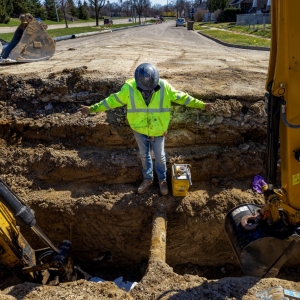 https://www.circleofblue.org/wp-content/uploads/2022/04/2022-04-14-Michigan-Waters-True-Cost-JGanter-1502-Edit-2500.jpg
912
1600
Brett Walton
https://www.circleofblue.org/wp-content/uploads/2018/06/Circle-of-Blue-Water-Speaks-600x139.png
Brett Walton2022-05-02 07:18:482022-12-09 10:52:35After Decades of Neglect, Bill Coming Due for Michigan’s Water Infrastructure
https://www.circleofblue.org/wp-content/uploads/2022/04/2022-04-14-Michigan-Waters-True-Cost-JGanter-1502-Edit-2500.jpg
912
1600
Brett Walton
https://www.circleofblue.org/wp-content/uploads/2018/06/Circle-of-Blue-Water-Speaks-600x139.png
Brett Walton2022-05-02 07:18:482022-12-09 10:52:35After Decades of Neglect, Bill Coming Due for Michigan’s Water InfrastructureMany Rural Towns Have Neglected Drinking Water Systems for Decades
As some rural towns lose population and government funds shrink, some drinking water systems are one failure away from crisis.

Throughout the Great Lakes region and across the U.S., water systems are aging. In some communities, this means water bills that residents can’t afford or water that’s unsafe to drink. It means that vulnerable systems are even more at risk in a changing climate. From shrinking cities and small towns to the comparatively thriving suburbs, the true cost of water has been deferred for decades.
As the nation prepares to pour hundreds of billions of federal dollars into rescuing water systems, the Great Lakes News Collaborative investigates the true cost of water in Michigan.
This is part two of a ten-part series.
Lester Graham, Michigan Radio – May 3, 2022
It’s a chilly day, but the sky is clear and the sun makes it seem just a little warmer than it actually is in Akron, a small town near the crook of Michigan’s “Thumb.” The village is surrounded by two huge installations of wind turbines, which can be seen extending to the horizon no matter which way you look.
“Which way am I going,” I asked my passenger, Marvin Hasso, Jr., as we pulled away from the Akron Village Hall to take a look at the town’s water tower and wells.
“Well, I guess you want to see downtown this way,” said Hasso, the one-man Department of Public Works for the village. He’s had this job off and on for decades because Akron has struggled to keep staff.
It’s also struggled to pay for its infrastructure – especially its water system.
We turned a corner, and Hasso pointed at a small light-blue tower.
“The biggest issue is really the size. They would like you to have a day and a half’s worth of water. And we don’t even have a day’s worth of water in our tower,” Hasso said.
Having extra water comes in handy when there’s a fire in town. Because the tower is so small, the firefighters can only pull water from a fire hydrant for a short time. Any longer and the water pressure gets too low, then a boil water order has to be issued.
The fire department – where Hasso is chief – has a tanker truck to haul water to fires. Most rural communities have tanker trucks because houses and farms outside of town aren’t hooked up to a water system, so they don’t have fire hydrants. It’s common practice for other departments to send tanker trucks to assist neighboring communities.
While many of Michigan’s communities get water from the Great Lakes, many rural communities are too far away. They often rely on wells.
Akron’s experience is a common one in many areas of Michigan where shrinking populations, growing poverty, and diminished state and federal assistance have fueled a crisis of underfunded drinking water infrastructure. Those problems often are compounded by a lack of qualified staff to keep up with water system operations and little to no expertise in applying for grants and loans that could help bolster utility budgets.
It’s just one facet of a broader crisis of decrepit infrastructure in Michigan, the Great Lakes News Collaborative has found.

The Village of Akron hopes to get a USDA grant to replace some -if not all- of it’s distribution system which was installed in the 1950s. Photo Lester Graham / Michigan Radio
Fewer people sharing greater costs
Akron sits about 20 miles east of I-75 at Bay City. The current population 349. Back in 1980, it had 538 residents, but – like a lot of rural towns – it’s seen a steady decline.
“We just lost our only barber shop,” Hasso said. He listed the businesses that had come and gone throughout the history of Akron. “Six barber shops, and hotels, grocery stores, gasoline stations, furniture stores. None of that’s here” anymore, he said with a sigh of resignation.
The last grocery store closed a few years ago. The collapsed structure that was the bowling alley was cleared away last year. A bar on the main drag closed recently. Akron is left with a convenience store and one bar to serve its residents. The other businesses primarily support agriculture.
Over the years, Akron has dug five wells to supply the village with water. Only two can be used today: a new one outside of town, and an old one at the water tower. If the new well had to shut down for some reason, the old one would not keep up with daily demand. The village is considering digging another well.
Families use a lot more water now than they did three generations ago. Dishwashers and washing machines, more bathrooms, and more frequent baths and showers stretch the limits of the aging water system.
Seventy years ago, the watertower and the distribution system were considered the right size, or maybe even over-built. It was assumed in the 1950s, there would be a couple of subdivisions eventually added. That didn’t happen. The distribution system is now too big for the number of homes and businesses and the watertower has reached the end of its life expectancy, but the smaller population still has to pay for maintaining the system.
“We do repairs. If we have (a water main) break, we’ll replace a section. If we have a fire hydrant go bad, we’ll replace that. But by and large, it’s, you know, 98% the same system that went in in the late ‘50s,” Hasso said.
Over those decades, some of the water mains should have been replaced. But, the village board didn’t feel it had the money.
Akron also has to spend more on its water system. New lab tests are required by the state. All water departments are mandated to test for lead, PFAS, and other substances that have caused problems in Michigan. For larger systems, it’s a minor inconvenience. For small towns, the cost is not insignificant.
Mostly, the people of Akron don’t know there’s a problem with the water until it’s evident at home. When rust from an old valve loosens and gets into the water supply, it might ruin a load of laundry. It’s a nuisance, but most residents don’t recognize that it’s a sign of a water distribution system that’s reached the end of its life.
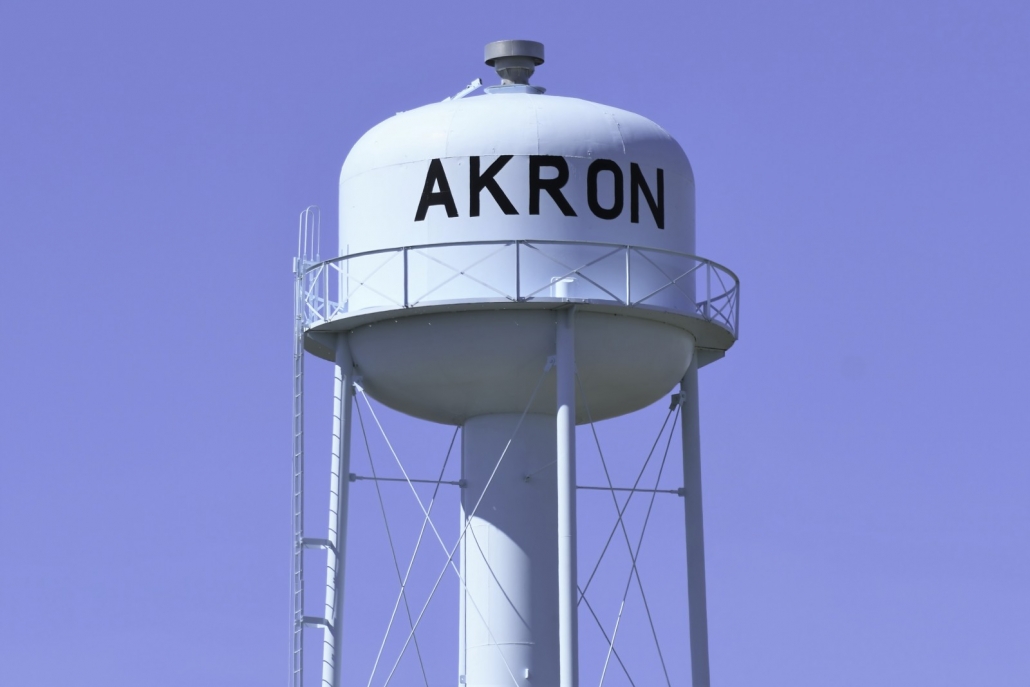
Akron’s water tower sits at the site of the village’s first well. Another well outside of town is the main supply. If it failed, the original well could not meet demand. Photo Lester Graham / Michigan Radio
Water bills don’t meet the actual costs
Ten years ago, the village asked the Michigan Rural Water Association to take a look at the system. The association told the Village Board it wasn’t charging customers enough. It needed to raise its water rates to better maintain the system. The Board did raise the price it billed customers, but not by as much as recommended. It just didn’t think residents could afford a bigger price hike. Akron’s median household income is $43,000 a year compared to the state’s median of nearly $60,000 a year.
“Too many small systems haven’t been charging accurate rates for longest time because city council, villages, township boards, you know, a lot of times some think they’re doing the right thing by not raising rates and in the long run that hurts them,” said Tim Neumann, executive director of the Michigan Rural Water Association.
For a lot of small towns’ leaders, keeping the roads in good shape and making the village park look nice are priorities. That’s what people notice. You can’t see how bad the water distribution system might be.
“All this stuff’s buried underground, out of sight, out of mind, and just come to expect that turn the tap on water comes out. So unfortunately, just like with our roads and stuff like that, you know, our water and sewer systems have been neglected over the years,” Neumann said.
His organization has worked with communities that have gone five, ten, even 15 years without raising water rates. Then they have major problems and the rates suddenly have to be raised, sometimes by 50 percent or more. Neumann said if those town leaders would have increased the price at just the rate of inflation, they would have had more money to deal with infrastructure problems before they became emergency repairs.
“There is a general lack of political will, certainly. Raising people’s water rates doesn’t get you reelected,” said Eric Oswald, director of the Drinking Water and Environmental Health Division of the Michigan Department of Environment, Great Lakes, and Energy (EGLE).
He’s familiar with Akron’s water tower, which he said has exceeded its life expectancy. And he knows about the wells and the distribution system designed for a bigger population.
“That’s a very good example of a very difficult problem with a very small ratepayer base and an oversized system,” he confirmed.
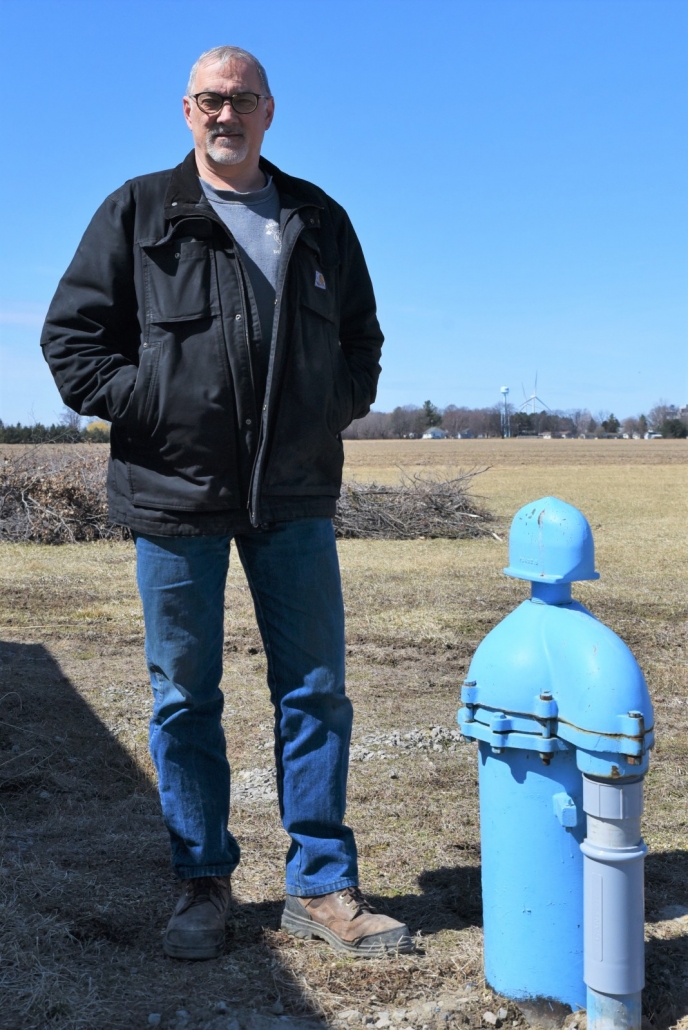
Marvin Hasso, Jr. is the Village of Akron’s one-person Public Works Department. He stands at the village’s main well outside of town. Photo Lester Graham / Michigan Radio
Can’t afford government loans
A program that is available to communities for major repairs is the Drinking Water State Revolving Fund. It’s federal funds that the states distribute in low interest loans, with a certain amount each year that can be given to communities as grants, or with principal forgiveness, or negative interest rate loans.
A study by the University of Michigan found that Michigan was dead last among the states for the number of municipalities accessing the State Revolving Fund loans.
“Part of our problem in the past is … our interest rates haven’t been that competitive with what they can get on the outside of the state,” Oswald said.
He added that the legislature and his agency are working toward a solution.
Akron and other small rural communities have the option of passing up the State Revolving Fund in favor of loans, some of them forgivable, through the U.S. Department of Agriculture’s Rural Development and Environmental Programs. It’s a good fit for small, disadvantaged communities. Akron is exploring that option.
There are reasons why some small towns don’t apply for these kinds of loans. They might not be able to afford the debt. Also, it takes a lot of money to hire contractors to determine a system’s assets. That’s needed in order to apply for the loans. A lot of these small towns don’t have the expertise needed to fill out an application on their own. It’s a big expense and there’s no guarantee the town will get a loan or grant.
EGLE said it will work with communities to determine whether they have a fighting chance to get a State Revolving Fund loan and it’s worth the risk to hire consultants.
But recently another option has become available. The Michigan Municipal League Foundation announced a program called the Water Navigator service. It’s free to communities because it’s funded by private grants. It’s designed to give the help some smaller communities need.
“To help them get applications ready, to help them get applications submitted, and to navigate all of the kind of complex nuances that come into drinking water infrastructure funding at the state and federal levels,” said Grace Carey, program officer of the Foundation.
The organization is working with a private firm, OHM Advisors, which will guide municipalities through determining infrastructure needs, funding programs, water rates, and water affordability.
Affordability has become an issue on which the public is challenging water utilities. With a backlash in some cities to water shutoffs, water departments are trying to come up with alternatives for customers who cannot afford to pay their water bill. Shutting off access to drinking water and basic sanitation to families is becoming a greater political concern, let alone a humanitarian concern.
There’s a fair amount of enthusiasm lately among cities about money to fix some of Michigan’s water problems. The legislature and the governor approved nearly $2 billion in federal stimulus funds to improve aging water infrastructure. Michigan government leaders are also looking forward to the funds from the Infrastructure Investment and Jobs Act, more often called the Bipartisan Infrastructure Law. As its name implies, that federal windfall is also to be used to repair, replace, or build infrastructure.
But the influx of federal money is not nearly enough to fix Michigan’s water infrastructure problems. In its most recent report, the American Society of Civil Engineers gave Michigan the grade of D for the poor shape of drinking water infrastructure across the state. It cites a Public Sector Consultants report that projects failure to adequately plan for and fund drinking water infrastructure could lead to major crises affecting millions of the state’s residents. And a 2018 report estimates that water system owners in Michigan are underfunding improvements needed to comply with the Safe Drinking Water Act at up to $563 million each year.
The U.S. Environmental Protection Agency’s Water Infrastructure Needs Survey and Assessment indicates Michigan needed to spend $13 billion to fix its drinking water systems as of 2015. The new federal money won’t come close to that kind of money.
Some experts say part of the long-term solution for rural communities is working together. They say it makes sense for towns that are near each other to explore whether they can share equipment or consolidate systems to produce potentially better drinking water at a lower cost.
“You’d be amazed at how hard they push back against suggestions about cooperation and working together,” said Eric Oswald at EGLE.
He concedes there are some legitimate concerns about loss of control.
“But, I think we need to get more efficient about how we deliver our water and how we operate our water systems in the state,” he said.
At the Michigan Rural Water Association, Tim Neumann agrees.
“Some of these systems … in my opinion, should be combined because it’s going to help them in the long run.”
Read the full series
 https://www.circleofblue.org/wp-content/uploads/2022/04/2022-04-14-Michigan-Waters-True-Cost-JGanter-1502-Edit-2500.jpg
912
1600
Brett Walton
https://www.circleofblue.org/wp-content/uploads/2018/06/Circle-of-Blue-Water-Speaks-600x139.png
Brett Walton2022-05-02 07:18:482022-12-09 10:52:35After Decades of Neglect, Bill Coming Due for Michigan’s Water Infrastructure
https://www.circleofblue.org/wp-content/uploads/2022/04/2022-04-14-Michigan-Waters-True-Cost-JGanter-1502-Edit-2500.jpg
912
1600
Brett Walton
https://www.circleofblue.org/wp-content/uploads/2018/06/Circle-of-Blue-Water-Speaks-600x139.png
Brett Walton2022-05-02 07:18:482022-12-09 10:52:35After Decades of Neglect, Bill Coming Due for Michigan’s Water Infrastructure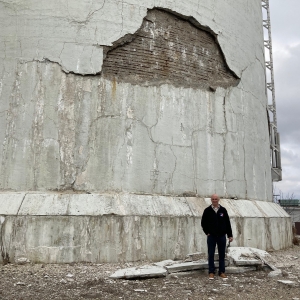
Water Woes Loom for Michigan Suburbs, Towns After Decades of Disinvestment
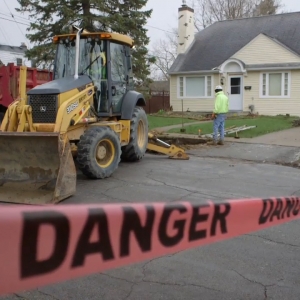
Michigan’s 20th Century Water Systems Too Big For Its Shrinking City Populations
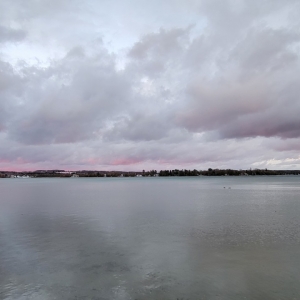
Michigan’s Lack of Septic System Regulations is Causing Problems for Some of its Most Pristine Lakes
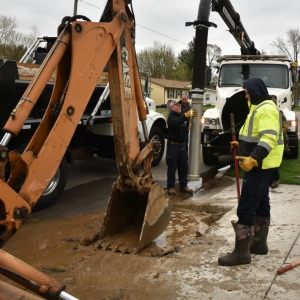
Short-Changing Michigan Local Governments Has Resulted in Deteriorating Water Systems and Other Services
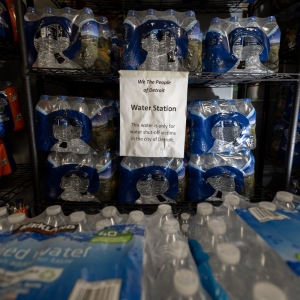
High Cost of Water Hits Home
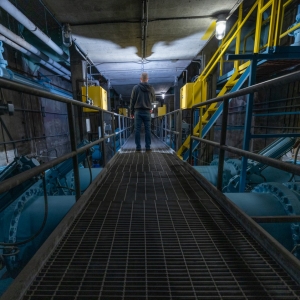
Some Michigan Water Systems Are Overbuilt, Underfunded. Are Mergers The Answer?
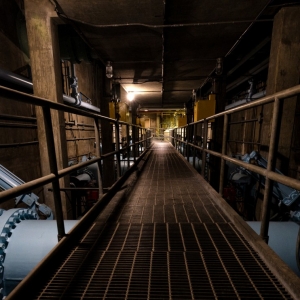
Michigan’s ‘Very Big Opportunity’ in Infrastructure Windfall
Water’s True Cost
The Great Lakes News Collaborative includes Bridge Michigan; Circle of Blue; Great Lakes Now at Detroit Public Television; and Michigan Radio, Michigan’s NPR News Leader; who work together to bring audiences news and information about the impact of climate change, pollution, and aging infrastructure on the Great Lakes and drinking water. This independent journalism is supported by the Charles Stewart Mott Foundation. Find all the work here.
Related
© 2023 Circle of Blue – all rights reserved
Terms of Service | Privacy Policy

